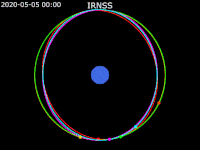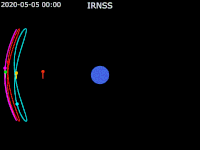IRNSS-1G

 | |
| Mission type | Navigation |
|---|---|
| Operator | ISRO |
| COSPAR ID | 2016-027A |
| SATCAT no. | 41469 |
| Mission duration | 12 years |
| Spacecraft properties | |
| Spacecraft | IRNSS-1G |
| Spacecraft type | Satellite |
| Bus | I-1K |
| Manufacturer | ISRO Satellite Centre Space Applications Centre |
| Launch mass | 1,425 kilograms (3,142 lb) |
| Dry mass | 598 kilograms (1,318 lb) |
| Power | 1600 W |
| Start of mission | |
| Launch date | 12:50:00, April 28, 2016 (UTC+05:30) |
| Rocket | PSLV-XL C33 |
| Launch site | Satish Dhawan (First) |
| Contractor | ISRO |
| Orbital parameters | |
| Reference system | Geocentric |
| Regime | Geosynchronous Orbit (GSO) |
| Longitude | 129.429213 East |
| Perigee altitude | 35,780.961 km (22,233.258 mi)[1] |
| Apogee altitude | 35,796.200 km (22,242.727 mi)[1] |
| Inclination | 4.2637 |
| Period | 23:56:12.33 |
| Epoch | 17151.68965311 |
IRNSS-1G was the seventh and final[2] of the Indian Regional Navigation Satellite System (IRNSS) series of satellites after IRNSS-1A, IRNSS-1B, IRNSS-1C, IRNSS-1D, IRNSS-1E and IRNSS-1F. This system of satellites will provide navigational services to the Indian region. The satellite was launched successfully on 28 April 2016 at 07:20 UTC.[2]
IRNSS-1G along IRNSS-1A is being used only for NavIC's short message broadcast service and not for navigation.[3][4]
Launch
[edit]The satellite was launched from the First Launch Pad (FLP) of Satish Dhawan Space Centre, Sriharikota on board PSLV-C33 XL on 28 April 2016 at 12:50 PM IST.[2][5] The countdown of the launch had begun 51:30 hours before at 9:20 AM IST on 25 April 2016.[6]
After the launch of IRNSS-1G the Indian government named the IRNSS system as NAVIC (Navigation with Indian Constellation).[7]
Specifications
[edit]Mission life: 12 years (planned).[6]
Lift-off mass:1,425 kilograms (3,142 lb)
Dry mass: 598 kilograms (1,318 lb).[8]
Payload: CDMA ranging payload in C band.[9][10] Navigation payload in L-5 and S band spectrums and Rubidium atomic clocks.[11]
Power: Two triple-junction solar panels to generate 1660W of energy and one Lithium-ion 90A-hr battery is used.[8]
Propulsion: MMH/MON3 based bipropellant system with 12×22N Attitude control thrusters and one 440N LAM.[10]
Orbit: Geosynchronous orbit at 129.5° East longitude with 5° inclination.[8][12]
Cost: Approximately ₹125 crore (US$15 million).[13]
See also
[edit]- Communication-Centric Intelligence Satellite (CCI-Sat)
- GPS-aided geo-augmented navigation (GAGAN)
- Satellite navigation
References
[edit]- ^ a b "NORAD Catalog Number 41469". NORAD. Retrieved 2 June 2017.
- ^ a b c "India launches seventh navigation satellite, to get its own GPS". The Hindu. 28 April 2016. Retrieved 28 April 2016.
- ^ "Annual Report 2019-20". Department of Space. Archived from the original on 6 April 2020. Retrieved 5 March 2020.
- ^ "ANNUAL REPORT 2020-2021" (PDF). ISRO. Archived from the original (PDF) on 25 April 2021. Retrieved 6 March 2021.
- ^ "PSLV-C33/IRNSS-1G". ISRO. Archived from the original on 28 April 2016. Retrieved 28 April 2016.
- ^ a b PTI (26 April 2016). "Countdown for IRNSS-1G launch begins at Sriharikota". The Hindu. Retrieved 28 April 2016.
- ^ "PSLV-C33 Successfully Launches India's Seventh Navigation Satellite IRNSS-1G - ISRO". www.isro.gov.in. Archived from the original on 1 November 2021. Retrieved 1 November 2021.
- ^ a b c "PSLV-C33 - IRNSS-1G Specifications" (PDF). ISRO. Archived from the original (PDF) on 25 April 2016. Retrieved 28 April 2016.
- ^ "'Isro launches rocket carrying India's seventh navigation satellite'". Business Standard. 28 April 2016. Retrieved 28 April 2016.
- ^ a b "SALIENT FEATURES OF IRNSS 1G". www.ursc.gov.in. Retrieved 1 November 2021.
- ^ "IRNSS-1G". ISRO. Archived from the original on 24 April 2016. Retrieved 28 April 2016.
- ^ Sangeeta Ojha (28 April 2016). "India's own navigation satellite IRNSS-1G launched: All you need to know about it". India Today. Retrieved 28 April 2016.
- ^ Vanita Srivastava (1 May 2016). "IRNSS: Desi GPS to liberate India from dependence on US, Russia". Economic Times. Retrieved 2 May 2016.






